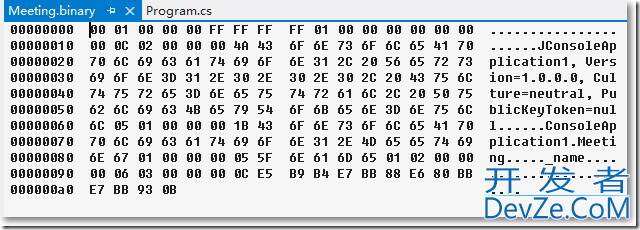序列化是将对象转换成字节流的过程,反序列化是把字节流转换成对象的过程。对象一旦被序列化,就可以把对象状态保存到硬盘的某个位置,甚至还可以通过网络发送给另外一台机器上运行的进程。本篇主要包括:
使用BinaryFormatter类进行序列化和反序列化
使用ISerializable接口自定义序列化过程
使用XMLSerializer类进行序列化和反序列化
使用BinaryFormatter类进行序列化和反序列化
首先把需要序列化的类打上[Serializable]特性,如果某个字段不需要被序列化,就打上[NonSerialized]特性。
[Serializable]
public class Meeting
{
public string _name;
[NonSerialized]
public string _location;
public Meeting(string name, string location)
{
this._name = name;
this._location = location;
}
}
对象序列化后需要一个载体文件,以下的Meeting.binary文件用来存储对象的状态。
static void Main(string[] args)
{
Meeting m1 = new Meeting("年终总结","青岛");
Meeting m2;
//先序列化
SerializedwithBinaryFormatter(m1,"Meeting.binary");
m2 = (Meeting) DeserializeWithBinaryFormatter("Meeting.binary");
Console.WriteLine(m2._name);
Console.WriteLine(m2._location ?? "_location字段没有被序列化");
Console.ReadKey();
}
//序列化
static void SerializedWithBinaryFormatter(object obj, string fileName)
{
//打开文件写成流
Stream streamOut = File.OpenWrite(fileName);
BinaryFormatter formatter = new BinaryFormatter();
//把对象序列化到流中
formatter.Serialize(streamOut, obj);
//关闭流
streamOut.Close();
}
//反序列化
static object DeserializeWithBinaryFormatter(string fileName)
{
//打开文件读成流
Stream streamIn = File.OpenRead(fileName);
BinaryFormatter formatter = new BinaryFormatter();
object obj = formatter.Deserialize(streamIn);
streamIn.Close();
return obj;
}
Meeting.binary文件在bin/debug文件夹中。
使用ISerializable接口自定义序列化过程
如果想对序列化的过程有更多的控制,应该使用ISerializable接口,通过它的GetObjectData方法可以改变对象的字段值。
[Serializable]
public class Location : ISerializable
{
public int x;
public int y;
public string name;
public Location(int x, int y, string name)
{
this.x = x;
this.y = y;
this.name = name;
}
protected Location(SerializationInfo info, StreamingContext context)
{
x = info.GetInt32("i");
y = info.GetInt32("j");
name = info.GetString("k");
}
public void GetObjectData(SerializationInfo info, StreamingContext context)
{
info.AddValue("i", x + 1);
info.AddValue("j", y + 1);
info.AddValue("k", name + "HELLO");
}
}
开发者_Go入门以上,不仅要实现接口方法GetObjectData,还需要提供对象的重载构造函数,从SerializationInfo实例中获取值。
在客户端:
Location loc1 = new Location(1,2,"qingdao");
Location loc2;
//序列化
SerializedWithBinaryFormatter(loc1, "Location.binary");
loc2 = (Location) DeserializeWithBinaryFormatter("Locatiandroidon.binary");
Console.WriteLine(loc2.x);
Console.WriteLine(loc2.y);
Console.WriteLine(loc2.name);
Console.ReadKey();
以上,使用BinaryFormatter类进行序列化和反序列化,存储的文件格式是二进制的,例如,打开Meeting.binary文件,我们看到:

有时候,我们希望文件的格式是xml。
使用XmlSerializer类进行序列化和反序列化
XmlSerializer类进行序列化的存储文件是xml格式。用XmlSerializer类进行序列化的类不需要打上[Serializable]特性。
public class Car
{
[XmlAttribute(AttributeName = "model")]
public string type;
public string code;
[XmlIgnore]
public int age;
[XmlElement(ElementName = "mileage")]
public int miles;
public Status status;
public enum Status
{
[XmlEnum("使用中")]
Normal,
[XmlEnum("修复中")]
NotUse,
[XmlEnum("不再使用")]
Deleted
}
}
在客户端:
//打开写进流
Stream streamOut = File.OpenWrite("Car.xml");
System.Xml.Serialization.XmlSerializer x = new XmlSerializer(car1.GetType());
//序列化到流中
x.Serialize(streamOut, car1);
streamOut.Close();
//打开读流
Stream streamIn = File.OpenRead("Car.xml");
//反序列化
Car car2 = (Car) x.Deserialize(streamIn);
Console.WriteLine(car2.type);
Console.WriteLine(car2.code);
Console.WriteLine(car2.miles);
Console.WriteLine(car2.status);
Console.ReadKey();
运行,打开bin/debug中的Car.xml文件如下:
<?xml version="1.0"?> <Car xmlns:xsi="http://www.w3.org/2001/XMjsLSchema-instance" xmlns:xsd="http://www.w3.org/2001/XMLSchema" model="sedan"> <code>001</code> <mileage>1000</mileage> <status>使用中</status> </Car>
- 类名Car成了xml的根节点
- 打上[XmlAttribute(AttributeName = "model")]特性的字段变成了根节点的属性,AttributeName为属性别名
- 枚举项可打上[XmlEnum("使用中")]特性
如果一个类中包含集合属性,比如以下的Department类包含一个类型List<Employee>的集合属性Employees。
public class Department
{
public Department()
{编程客栈
Employees = new List<Employee>();
}
public string Name { get; set; }
[XmlArray("Staff")]
public List<编程客栈;Employee> Employees { get; set; }
}
public class Employee
{
public string Name { get; set; }
public Employee()
{
}
public Employee(string name)
{
Name = name;
}
}
在客户端:
class Program
{
static void Main(string[] args)
{
var department = new Department();
department.Name = "销售部";
department.Employees.Add(new Employee("张三"));
department.Employees.Add(new Employee("李四"));
XmlSerializer serializer = new XmlSerializer(department.GetType());
//打开写进流
Stream streamOut = File.OpenWrite("Department.xml");
serializer.Serialize(streamOut, department);
streamOut.Close();
}
}
查看bin/debug中的Department.xml文件。
<?xml version="1.0"?>
<Department xmlns:xsi="http://www.w3.org/2001/XMLSchema-instance" xmlns:xsd="http://www.w3.org/2001/XMLSchema">
<Name>销售部</Name>
<Staff>
<Employee>
<Name>张三</Name>
</Employee>
<Employee>
<Name>李四</Name>
</Employee>
</Staff>
</Department>
总结:
- 1、使用BinaryFormatter类序列化到二进制文件
- 2、使用XmlSerializer类序列化到xml文件
- 3、使用ISerializable接口自定义序列化过程
以上就是这篇文章的全部内容了,希望本文的内编程容对大家的学习或者工作具有一定的参考学习价值,谢谢大家对我们的支持。如果你想了解更多相关内容请查看下面相关链接









 加载中,请稍侯......
加载中,请稍侯......
精彩评论